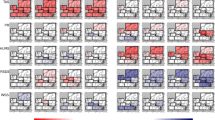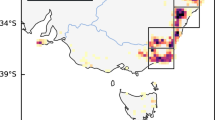Abstract
An ensemble simulation system that accounts for uncertainty in long-range weather conditions and two-dimensional wildland fire spread is described. Fuel moisture is expressed based on the energy release component, a US fire danger rating index, and its variation throughout the fire season is modeled using time series analysis of historical weather data. This analysis is used to characterize the seasonal trend in ERC, autocorrelation of residuals, and daily standard deviation and stochastically generate artificial time series of afternoon fuel moisture. Daily wind speed and direction are sampled stochastically from joint probabilities of historical wind speed and direction for the date range of the fire simulation period. Hundreds or thousands of fire growth simulations are then performed using the synthetic fire weather sequences. The performance of these methods is evaluated in terms of the number of ensemble member simulations, one- versus two-dimensional fire spread simulations, and comparison with results from 91 fires occurring from 2007 to 2009. Simulations were found to be in consistent agreement with observations, but trends indicate that the ensemble average of simulated fire sizes were consistently larger than actual fires whereas the farthest extent burned by fires was underestimated.







Similar content being viewed by others
References
Ager, A. A., Finney, M. A., Kerns, B. K., & Maffei, H. (2007). Modeling wildfire risk to northern spotted owl (Strix occidentalis caurina) habitat in Central Oregon USA. Forest Ecology and Management, 246, 45–56.
Albini, F.A. (1979). Spot fire distance from burning trees—A predictive model. USDA For. Serv. Gen. Tech. Rep. INT-56.
Anderson K.R., Flannigan M.D., & Reuter G. (2005). Using ensemble techniques in fire-growth modelling. In: 6th Symp. on Fire and Forest Meteorology, vol. 2.4. Canmore, Alberta Amer Meteorol Soc, Boston, MA, pp 1–6, 24–27, Oct 2005
Anderson, K., Reuter, G., & Flannigan, M. D. (2007). Fire-growth modeling using meteorological data with random and systematic perturbations. International Journal of Wildland Fire, 16, 174–182.
Andre, J. C. S., Urban, J. M., & Viegas, D. X. (2006). Forest fire spread models: The local quasi-equilibrium approach. Combustion Science Technology, 178(10–12), 2115–2143.
Andrews, P.L. (1986). BEHAVE: Fire behavior prediction and fuel modeling system—BURN subsystem Part 1. USDA For. Serv. Gen Tech. Rep. INT-194.
Andrews, P. L., Loftsgaarden, D. O., & Bradshaw, L. S. (2003). Evaluation of fire danger rating indexes using logistic regression and percentile analysis. International Journal of Wildland Fire, 12, 213–226.
Barrows, J.S. (1951). Fire behavior in the northern Rocky Mountain forests. USDA Forest Service Station Paper Number 29, 103 pages.
Box, G., & Jenkins, G. (1976). Time series analysis: Forecasting and control. San Francisco: Holden Day.
Boychuk, D., Braun, W. J., Kulperger, R. J., Kroughly, Z. L., & Stanford, D. A. (2009). A stochastic fire growth model. Environmental and Ecological Statistics, 16, 133–151.
Bradshaw, L.S., Deeming, D.A. Burgan, R.E., & Cohen, J.D. (1983). The 1978 National Fire-Danger Rating System: Technical documentation. United States Department of Agriculture, Forest Service, General Technical Report INT-169. Intermountain Research Station, Ogden, Utah, 44 pages.
Braun, W.J., Jones, B.L., Lee, J.SW., Woodford, D.G., & Wotton, B.M. (2010). Forest fire risk assessment: An illustrative example from Ontario, Canada. Journal of Probability and Statistics 2010, 823018, 26 pages
Brown, A. A., & Davis, K. P. (1973). Forest fire control and use (McGraw Hill series in forest resources). New York: McGraw-Hill. 686 pages.
Butler, B. W., Forthofer, J. M., Stratton, R. D., Finney, M. A., & Bradshaw, L. S. (2005). Fire growth simulations of the Price Canyon, Thirtymile, and Storm King mountain fire using high resolution wind simulation tools and FARSITE. Sixth Symposium on Fire and Forest Meteorology, Oct. 25–27, Canmore, AB, Canada
Byram, G. M. (1959). Combustion of forest fuels. In K. P. Davis (Ed.), Forest fire: Control and use. New York: McGraw-Hill.
Catchpole, E. A., Hatton, T. J., & Catchpole, W. R. (1989). Fire spread through nonhomogeneous fuel modeled as a Markov process. Ecological Modelling, 48, 101–112.
Calkin D.E., Ager, A.A., Gilbertson-Day, J., Scott, J.H., Finney, M.A., Schrader-Patton, C., Quigley, T.M., Strittholt, J.R., & Kaiden, J.D. (2010). Wildfire risk and hazard: Procedures for the first approximation. US Forest Service, Rocky Mountain Research Station RMRS-GTR-235.
Colemen, J. R., & Sullivan, A. L. (1996). A real-time computer application for the prediction of fire spread across the Australian landscape. Simulation, 67(4), 230–240.
Deeming, J.E., Burgan, R.E., & Cohen, J.D. (1977). The national fire-danger rating system—1978. USDA For. And Range Exp. Station, Gen. Tech. Rep. INT-39.
Finney M.A. (1998). FARSITE: Fire area simulator—Model development and evaluation. USDA For. Serv. Res. Pap. RMRS-RP-4
Finney, M. A. (2002). Fire growth using minimum travel time methods. Canadian Journal of Forest Research, 32(8), 1420–1424.
Finney, M. A. (2003). Calculation of fire spread rates across random landscapes. International Journal of Wildland Fire, 12, 167–174.
Finney, M. A. (2005). The challenge of quantitative risk analysis for wildland fire. Forest Ecology and Management, 211, 97–108.
Finney, M.A. (2006). An overview of FlamMap fire modeling capabilities. USDA For. Serv. Gen. Tech. Rep. RMRS-P-41, pp. 213–220.
Fosberg, M.A. & Deeming, J.E. (1971). Derivation of the 1- and 10-hour time lag fuel moisture calculations for fire danger rating. United States Department of Agriculture, Forest Service, Research Note RM-207. Rocky Mountain Forest Experimental Station, Fort Collins, Colorado, 8 pages.
Fujioka, F. M. (1985). Estimating wildland fire rate of spread in a spatially non-uniform environment. Forest Science, 31(3), 21–29.
Kalvova, J., & Sobisek, B. (1981). Periodicity in time series of wind direction data. Studia Geophysica Et. Geodaetica, 25, 275–283.
Latham, D.J. & Rothermel, R.C. (1993). Probability of fire-stopping precipitation events. USDA For. Serv. Research Note INT-510, 8 pp.
Martell, D. L. (1999). A Markov chain model of day to day changes in the Canadian forest fire weather index. International Journal of Wildland Fire, 9(4), 265–273.
Martin, R. E. (1988). Rate of spread calculation for two fuels. Western Journal of Applied Forestry, 3(2), 54–55.
Massada, A. B., Radeloff, V. C., Stewart, S. I., & Hawbaker, T. J. (2009). Wildfire risk in the wildland -urban interface: A simulation study in northwestern Wisconsin. Forest Ecology and Management, 258, 1990–1999.
Negra, N. B., Holmstrom, O., Bak-Jensen, B., & Sorensen, P. (2008). Model of a synthetic wind speed time series generator. Wind Energy, 11, 193–209.
O’Regan, W. G., Kourtz, P., & Nozaki, S. (1976). Bias in the contagion analog to fire spread. Forest Science, 2(1), 61–68.
Parisien, M.G., Kafka, V.G., Hirsch, K.G., Todd, J.B., Lavoie, S.G., & Maczek, P.D. (2005). Mapping wildfire susceptibility with the BURN-P3 simulation model. Inf. Rep. NOR-X-405 Canadian Forest Service Northern Forestry Centre, 36 pages.
Peterson, S.H., Morais, M.E., Carlson, J.M., Dennison, P.E., Roberts, D.A., Mortiz, M.A., & Weise, D.R. (2009). Using HFire for spatial modeling of fire in shrublands. USDA For. Serv. Pac. Southwest Research Station, PSW-RP-259, 44 pages
Richards, G. D. (1990). An elliptical growth model of forest fire fronts and its numerical solution. International Journal for Numerical Methods Engineering, 30, 1163–1179.
Richards, G. D. (1999). The mathematical modelling and computer simulation of wildland fire perimeter growth over a 3-dimensional surface. International Journal of Wildland Fire, 9(3), 213–221.
Rothermel, R.C. (1972). A mathematical model for predicting fire spread in wildland fuels. USDA For. Serv. Res. Pap. INT-115.
Rothermel, R.C. (1983). How to predict the spread and intensity of forest and range fires. USDA For. Serv. Gen. Tech. Rep. INT-143
Rothermel, R.C. (1991). Predicting behavior and size of crown fires in the northern Rocky Mountains. USDA For. Serv. Res. Pap. INT-438.
Rothermel, R.C. (1998). Long range fire assessments. In K. Close & R.A. Bartlette (Eds.) Proc. Of the Interior West Fire Council Meeting and Symposium Coeur d’Alene, ID, November 1–3 1994, Intl. Asso. of Wildl. Fire, Fairfield, WA, pp 169–180.
Schroeder, M. J., & Buck, C. C. (1970). Fire weather: A guide for application of meteorological information to forest fire control operations. Agricultural Handbook: USDA. 360.
Scott, J.H. (2006). An analytical framework for quantifying wildland fire risk and fuel treatment benefit. In: P.L. Andrews & B.W. Butler (compilers) Fuel management—How to measure success: Conference Proceedings, 28–30 March, Portland OR, USDA For. Serv. Gen. Tech. Rep. RMRS-P-41, pp. 169–184.
Scott, J.H. & Burgan, R. (2005). Standard fire behavior fuel models: A comprehensive set for use with Rothermel’s surface fire spread model. USDA Forest Service, Rocky Mountain Research Station, General Technical Report RMRS-GTR-153
Silvillo, J. K., Ahlquist, J. E., & Toth, Z. (1997). An ensemble forecasting primer. Weather Forecasting, 12(4), 809–818.
Toth, Z., & Kalnay, E. (1997). Ensemble forecasting at NCEP and the breeding method. Monthly Weather Review, 125, 3297–3319.
Van Wagner, C. E. (1977). Conditions for the start and spread of crown fire. Canadian Journal of Forest Research, 7, 23–34.
Wiitala, M.R. & Carlton, D.W. (1994). Assessing long-term fire movement risk in wilderness fire management. In Proc. 12th conference on Fire Forest Meteorology, Oct. 26–28, Jekyll Island Georgia, Soc. Am. Foresters, Bethesda, MD.
Acknowledgements
The authors gratefully acknowledge the financial support facilitated by John Syzmoniak of the US Forest Service Washington Office division of Fire and Aviation Management. Larry Bradshaw provided advice and technical assistance with weather data and analysis. Karen Short offered many helpful comments.
Author information
Authors and Affiliations
Corresponding author
Appendix
Appendix
Rights and permissions
About this article
Cite this article
Finney, M.A., Grenfell, I.C., McHugh, C.W. et al. A Method for Ensemble Wildland Fire Simulation. Environ Model Assess 16, 153–167 (2011). https://doi.org/10.1007/s10666-010-9241-3
Received:
Accepted:
Published:
Issue Date:
DOI: https://doi.org/10.1007/s10666-010-9241-3




